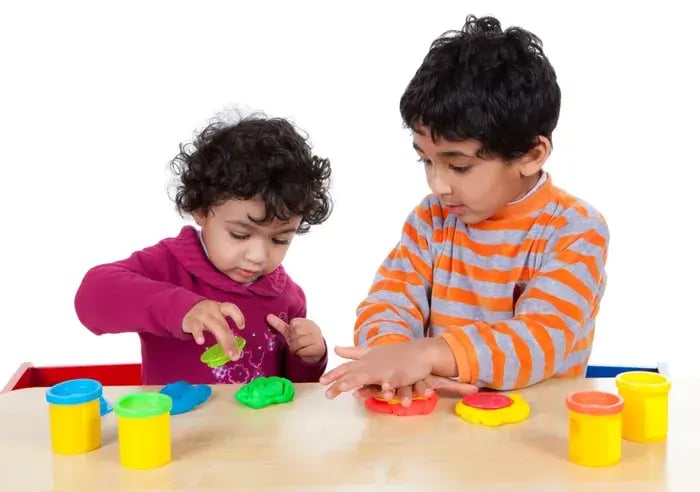- Offer Several Types of Clay
- Prepare a specific play area
- Teach through Play
- Storytelling with Clay Models
- Join the Fun
Introduction
Kids naturally like playing with their hands, and clay modeling allows creativity to come in line with learning. Shaping, molding, and experimenting with clay makes a child's play a significant learning activity as these skills can help them benefit in numerous ways. Fine motor skills, patience, and the ability to solve problems are promoted while keeping children busy for a long time, along with promoting sensory development due to the varied texture and shape that they would come across while molding the clay. Whether it's at home or in school, clay modeling can be an engaging, mess-free way to stimulate artistic expression and improve the learning of children. Here are some of the great benefits of clay modeling along with some tips from parents for best use.
Develops Fine Motor Skills

When kids work with clay, it requires a great deal of accuracy in hand movement, develops the muscles of fingers, and increases movement. These fine motor skills are also important for writing, drawing, and other such detailed works. While rolling, pinching, and molding clay, children refine their coordination and hand control, which further enhances their development during early childhood.
Encourages Creativity and Imagination
Clay modeling gives children the freedom to create anything they can think of. Unlike hard toys, clay allows open-ended play, enabling kids to build imaginative figures, animals, or objects. This creative expression makes clay modeling an excellent activity for developing independent thinking in kids learning.
Boosts Sensory Development
Playing with clay engages multiple senses, as children feel different textures, observe colors, and sometimes even smell the clay. These sensory experiences contribute to brain development by strengthening neural connections. Sensory play helps kids understand the world around them, improving cognitive growth and sensory integration.
Improves Hand-Eye Coordination
Clay modeling requires a fine hand movement and coordination between eyes and hands for delicate touch. Whether a child is carving a small animal or a large structure, this play enhances hand control. Improved hand-eye coordination helps strengthen other important skills including writing, cutting, and solving puzzles.
Strengthens Patience and Concentration
Clay modeling demands children go step by step, develop their work, and consequently, spend extended periods on a particular task. This process, by natural course, enhances the attention span and patience of children. Kids playing the clay activity to learn can accomplish the sense of achievement and fulfillment as they see their ideas take shape, building resilience and determination.
Enhances Emotional Expression
Children may find it difficult to express their emotions verbally, but through clay modeling, they can channel their feelings into their creations. Whether they are sculpting a joyful scene or a unique abstract design, clay provides an outlet for self-expression, helping kids communicate their thoughts and emotions more effectively.
Strengthens Problem-Solving Skills
Children overcome difficulties when working with clay, like how to get a figure to stand or balance different shapes. Overcoming these problems builds problem-solving skills and flexibility. The child who learns to problem solve while modeling clay will build resilience which will help him/her in the classroom and life in general.
5 Tips for Parents: Clay Modeling for Kids Learning
Offer Several Types of Clay

Different kinds of clay will be introduced, air-dry clay, playdough, or natural clay. Each kind of clay will have its unique texture and characteristics. This provides children with ways to explore and experiment. Having a variety of materials keeps the activity exciting and promotes sensory development.
Prepare a specific play area
Encourage independent exploration of clay modeling with a designated area. Use a mat or table cover to limit the mess as children play without restraint. Creating a creative zone will ensure the kids stay busy without distractions.
Teach through Play
Use clay modeling to teach. Allow children to form letters, numbers, or shapes to reinforce learning concepts. Such an activity helps make education a fun experience while making abstract concepts easier to learn.
Storytelling with Clay Models
Ask the children to tell stories of their creations. Whether they construct a castle, a farm, or an underwater world, this encourages storytelling that promotes language and communication skills. This is the best way to encourage imagination while connecting their ideas to real-world scenarios.
Join the Fun
Engage in clay modeling with your child to strengthen your bonds and foster collaborative play. Involvement of parents in creative activities shows an example; it creates confidence and encourages kids to learn well. Moreover, your participation allows guided learning and interaction.

Deepali is a senior food and wellness writer with over a decade of experience in top media houses, crafting engaging narratives. She is a professional home baker and loves exploring food from every corner of the world to reading cookbooks. She believes a healthy lifestyle is a combination of both mental and physical fitness. Her goal always remains to keep moving, eating seasonal and practicing gratitude.
The views expressed are that of the expert alone.
The information provided in this content is for informational purposes only and should not be considered a substitute for professional medical advice, diagnosis, or treatment. Always seek the advice of your physician or another qualified healthcare provider before making any significant changes to your diet, exercise, or medication routines.
References
https://www.fevicreate.com/web/fevicreate/-/blog/art-and-craft/benefits-of-clay-mmodelling-for-kids
https://www.eurokidsindia.com/blog/the-benefits-of-clay-modelling-for-kids.php
https://www.parentcircle.com/educational-benefits-of-playing-with-clay/article
















